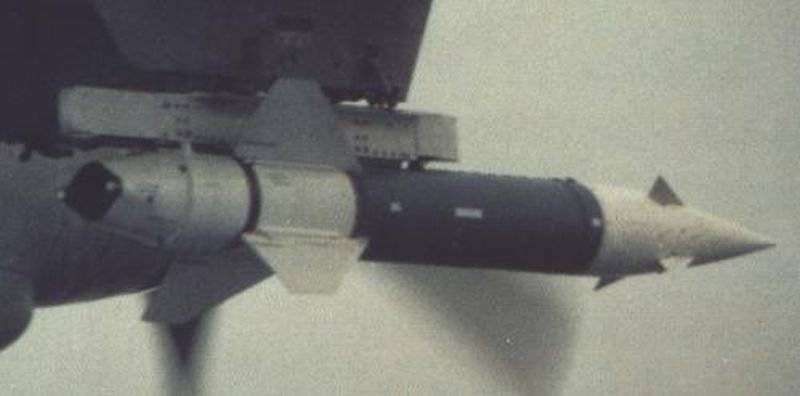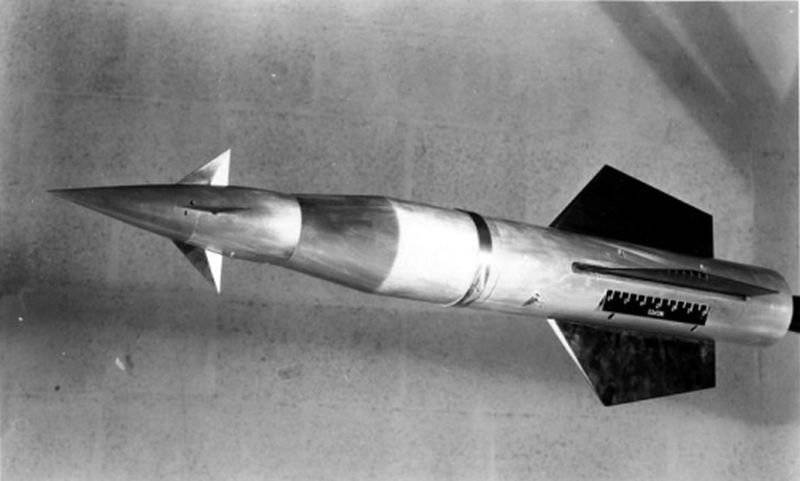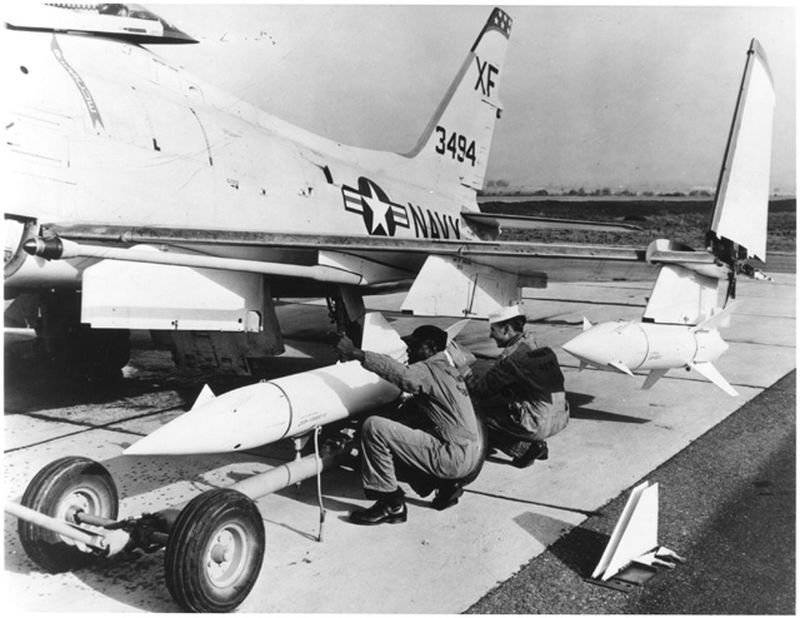ASM-N-7 "Bullpup" (AGM-12) - the first guided high-precision air-to-ground rocket (USA)

At that time, the nuclear arms race and the accuracy of hits were at the height of the world, as was the very high precision weapon, few people were interested. One of the first to recognize the need for precision weapons in the United States Armed Forces is the Navy. The defeat of tactical targets, usually heavily covered by anti-aircraft units, was very difficult in terms of defeat. The military operations in Korea, in particular the defeat of various types of bridges and crossings, covered by anti-aircraft units, cost the naval the fleet The United States has a lot of blood and considerable ammunition costs, while the tasks set were not 100% complete. This required the military leadership of the fleet to review the basic principles of the use of forces and armaments and look for more effective ways to accomplish assigned tasks. The United States has always been a supporter of a technical advantage over a potential adversary, so it is not surprising that several programs for the development of new types of weapons were launched immediately after the war. The fleet also formed its requirements for new weapons: they needed aviation guided missile weapons with the possibility of using them from a safe distance for tactical purposes, with a minimum of carrier presence in the enemy anti-aircraft armament. Also, a new missile should be able to hit small targets. And one more requirement - it should become inexpensive and fast in mass production with the possibility of production, if necessary, at any plant by any personnel. The latest requirements are echoes of nuclear buildup between world leaders, so that when a real nuclear confrontation arises, the production of new types of weapons does not stop.
The competition for the creation of AUR in 1954 was won by Martin with its project. In 1955, the company presented to the customer the first sample of the developed aviation guided missile. He was introduced as an ASM-N-7 "Bullpup" - a small rocket controlled by radio commands. The first launch from the AUR aircraft carrier took place in the middle of 1955. After there were four years of improvements, after which the rocket under the design name went into mass production.
The specification of the missile affected the main characteristics of the new weapons. The rocket was simple, but extremely primitive. The simplicity of the rocket control, determined its reliability, and the primitive guidance, requiring visual contact with the rocket of the pilot to complete aiming at the target, seemed to be a step backwards.
As a result, the rocket became a compromise between low cost and mass-scale production and reliability using advanced technologies. And even though the rocket suffered from unrecoverable illnesses during guidance, under optimal conditions of use, it showed phenomenal results for such simplified technologies.

Principle of operation
The pilot of the carrier aircraft before launching the guided missile, first visually determined the target, after which it launched the missile. When launching, the rocket, which had light-smoke tracers installed in the stern, showed the pilot a flight path. With the help of a special joystick, the pilot, guided by the tracers, controlled the flight of the rocket to the target. The guidance was carried out using the radio command system type AN / ARW-73 (AN / ARW-77).
Further modifications and upgrades ASM-N-7
The basic version of the rocket was produced no more than a year, after which in the 1960 year, the rocket was modified:
- Replaced solid propellant rocket motors with an improved liquid-jet engine Thiokol LR58-RM-4;
- increases the range of the missile to 11 kilometers.
This is quite enough at that time, and under the new name ASM-N-7a "Bullpup" the rocket is adopted and put into mass production. This model in a short time completely changed its progenitress into service.

However, the military demanded to improve the technical characteristics of the rocket. If in terms of range and accuracy there were no complaints, then the combat unit used was no longer satisfactory. For example, to damage a large well-equipped bridge, it was necessary to have at least two hits with this rocket. The military needed a high-precision rocket capable of hitting a similar target with a single hit.
The following modification occurred in the 1962 year. The rocket was called ASM-N-7a "Bullpup". The main difference is the use of a high-explosive fragmentation warhead weighing 450 a kilogram. The length of the rocket increased slightly due to the elongation of the nose for a new warhead. The range of the rocket remained virtually unchanged. In the 1964 year, I adopt the new modification and launch it into mass production.
At this time, the United States Air Force also shows interest in high-precision weapons. In addition, the ground forces were concerned about the lack of modern types of missile weapons and high-precision weapons. The Air Force, with 1955, was interested in developing “Bullpup” to fit its needs, but the creation of AUR for the Air Force under the White Lance program was strongly delayed for various reasons. As a result, the program of the Air Force used a modification of ASM-N-7a, which receives the designation GAM-83A. In 1963, all missiles produced for the Air Force and Navy are reduced to a single designation AGM-12С.
The next modification is the AGM-12D (GAM-83B) missile for the Air Force, which provided for the possibility of replacing a conventional warhead with a nuclear charge of 1 to 12 kilotons W-45. The main purpose is the use in the tactical zone of the front line from the carrier aircraft of the Air Force, where the use of conventional weapons was not sufficiently effective. It was assumed that with the help of these missiles, sufficient gaps will be made in the enemy’s defense structures, where they will be sent for a breakthrough tank United States compounds.

The latest modification of the AGM-12E rocket comes into service in the middle of the 1969 year. The main difference from the AGM-12C was the replacement of the warhead with a more modern cluster type, which had about 820 submunitions. The main purpose becomes areal defeat of targets and manpower of the enemy.
Combat application
All serial missiles of this series were used in combat operations by the United States in Vietnam, both the Air Force and the Navy. As a result of the analysis of combat operations, the use of these missiles was found to be satisfactory, although there were pronounced shortcomings:
- short range;
- inconvenient and outdated (true reliable) control and guidance system.
- traces left traces, led eventually to the complexity of the application and guidance;

Consequences of the use in hostilities, spurred the Soviet Union to develop such weapons. As a result, in the 1968 year, the X-23 rocket comes into service with the USSR Air Force. In addition to the Soviet Union, French engineers (AS-20) and Argentine (Pescador MP-1000) began to deal with such developments.
Fate of the rocket
The further development of high-precision missiles, modern technologies led to the creation of more sophisticated samples of self-guided high-precision AGM-65 type rockets. They, in turn, began to replace the entire series of “Bullpup” missiles. In total, over the years of mass production, around 30 thousands of Bullpup missiles were fired. The final decommissioning falls on 1980 years.
Results
The Aviation Guided Missile of the “Bullpup” series was not only the first of its kind, but also became the first model of general-purpose guided weapons. It could be installed on any type of aircraft, carry a nuclear charge and was quite reliable. The low effectiveness of missiles is primarily related to the technological problems of creating a guidance system at that time.
Key Features:
- Length - 3 meters;
- weight - 259 kilogram;
- engine - Aerojet MK 8;
- engine power - 53 Kn;
- Warhead - 113 caliber aerial bomb.
Information sources:
http://alternathistory.org.ua/agm-12-bullpup-pervyi-udachnyi-vysokotochnyi
http://www.designation-systems.net/dusrm/m-12.html
http://siris-archives.si.edu/ipac20/ipac.jsp?uri=full=3100001~!292296!0
http://www.militaryparitet.com/nomen/usa/rocket/data/ic_nomenusarocket/17/
Information